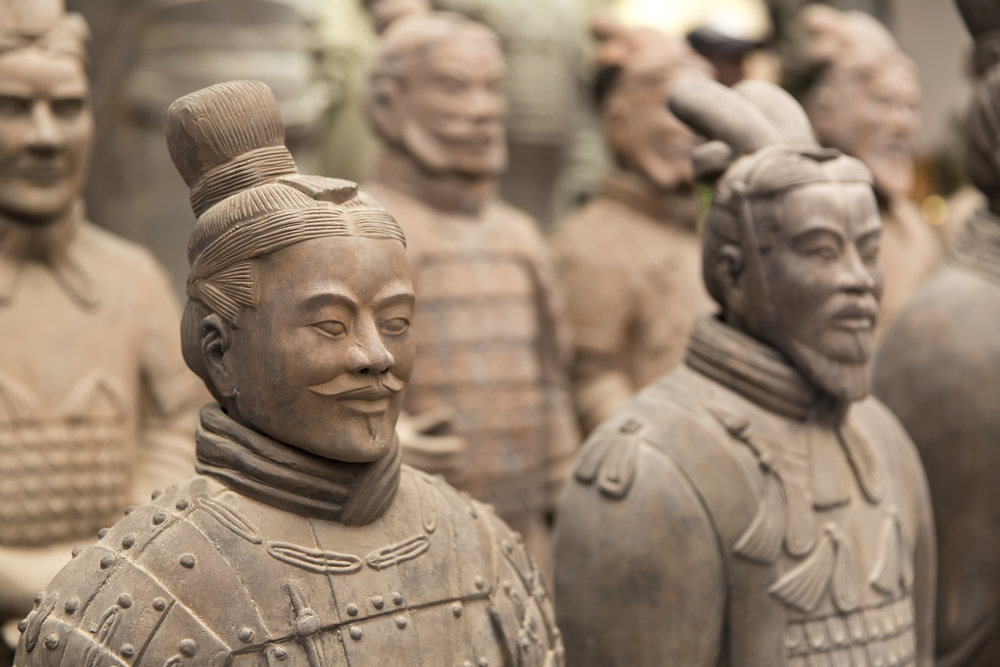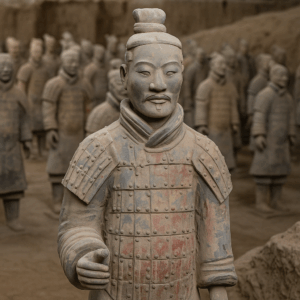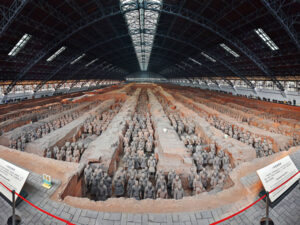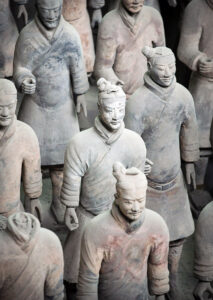Secrets of China’s Terracotta Army

Guardians of Qin Shi Huang’s Tomb
Disclosure: This article contains affiliate links. We may earn a commission if you make a purchase through these links, at no extra cost to you.
STEVE: Did you know the Terracotta Army is one of archaeology’s most staggering finds? Thousands of life-sized clay soldiers—each one different—buried with Emperor Qin Shi Huang in a hidden chamber beneath Xi’an. It’s like discovering an ancient time capsule of military might.
DAVE: Yeah, yeah, we’ve all seen the museum gift shop. But isn’t it just a little too perfect? I mean, 8,000 unique statues—infantry, cavalry, officers—all just waiting in formation? Convenient that nobody ‘found’ them until 1974, don’t you think?
STEVE: Well, UNESCO confirms the entire complex was deliberately designed as an underground army. Qin’s mausoleum was practically a miniature capital city—and these warriors were made to guard it in the afterlife.
DAVE: Or made to distract us in this one. You know I’ve got questions, Steve. Why no records? Why no earlier mentions from travelers? And how are they so detailed—down to the shoelaces—if this was all 2,200 years ago?
STEVE: That’s the mystery, isn’t it? But there’s no denying the craftsmanship. These statues have become a global symbol of ancient China’s legacy. Whether ceremonial or strategic, they stand as an unmatched archaeological marvel.
DAVE: Or a story with missing pages. Let’s see what else they’re not telling us.

[Image: A life-sized terracotta warrior statue unearthed in Pit 1 of Emperor Qin Shi Huang’s mausoleum in Xi’an, China. Each soldier was crafted with unique facial features and gear. (Image: Gary Todd, CC0)]
Emperor Qin’s Mausoleum and the Terracotta Army
STEVE: Emperor Qin Shi Huang wasn’t just the first emperor—he was a nation-builder. He unified the warring states, standardized script, currency, and even axle widths. According to UNESCO, he’s buried at the heart of an enormous burial complex designed to mirror his capital city.
DAVE: Convenient how it all lines up so neatly, huh? A model city underground, perfectly planned? Sounds a bit too textbook if you ask me.
STEVE: The Terracotta Army was just one part of that grand design. His tomb includes hundreds of pits—statues, weapons, ceremonial objects—you name it. And here’s the fascinating part: each figure was mass-produced but hand-finished. No two are exactly alike.
DAVE: Which also begs the question—why would a regime hellbent on uniformity suddenly want 8,000 unique clay faces? Seems like overkill for an afterlife bodyguard detail.
STEVE: Or a remarkable display of power and artistry. And don’t forget, the entire site earned UNESCO World Heritage status in 1987. That’s not handed out for flair—it’s for outstanding universal value.
DAVE: I’m not saying it’s not impressive. I’m just saying… when history lines up too perfectly, there’s usually more going on beneath the surface. Literally.
Discovery of the Army (1974)
STEVE: The Terracotta Army was discovered by accident. In March 1974, a group of farmers near Lintong District was digging a well when they unearthed pottery shards and human bones. Word of the find reached local authorities, who initiated a formal excavation. Within weeks, archaeologists began uncovering Pit 1 – a huge vaulted chamber containing thousands of standing clay warriors. Reports later described the site as “the greatest archaeological discovery of the 20th century.”
DAVE: And yet… nobody stumbled on it before? For over two thousand years? I mean, we’re talking thousands of life-size warriors and chariots just sitting there underfoot. Not even a tourist with a shovel?
STEVE: Well, they were buried deep, and many of the pits were sealed. Plus, this region wasn’t exactly a tourist hotspot until the ’70s. By combining UNESCO’s account with modern sources, we know that Pit 1 contained about 6,000 figures.
DAVE: Uh-huh. And just when China was opening up to the world, this miraculous PR-friendly discovery surfaces. You’ve got to admit the timing is… cinematic.
STEVE: In total, roughly 2,000 statues and 130 chariots have been recovered so far; many more remain entombed. The travel site TravelChinaGuide notes that this is “the largest and most intricate assemblage of pottery figurines in ancient Chinese history.” Each warrior originally bore bright paints and stood in military formation. Unfortunately, exposure to air caused most of the pigment to flake off, leaving them in an earthy gray tone today.

[Image: View of multiple terracotta warriors in formation. Each statue in the army was individually sculpted; even the armor and mustache vary from soldier to soldier. (Image: Peter Morgan, CC BY 2.0)]
The Warrior Pits and Figures
The Terracotta Army is arranged in several pits near the mausoleum. Pit 1 is by far the largest and most well-known: it’s roughly 230 m long by 62 m wide (equivalent to two football fields) and contains about 6,000 figures in tightly packed battle formation. Here you find the full imperial guard – ranks of infantry, archers (standing and kneeling), and cavalry, accompanied by horses and chariots. Pit 2 is smaller (around 6,000 m²) but more complex: it contains combined arms formations with cavalrymen, charioteers and crossbowmen in mixed units. Today Pit 2 remains under excavation; visitors to the site can see archaeologists working amidst the figures. Pit 3 is much smaller (about 520 m²) with only 68 warriors and a single four-horse chariot; scholars believe Pit 3 may have been a command post or central headquarters for the army. Notably, Pit 3 was never burned like the others, so some of its clay figures still retain traces of original paint when first excavated.
In addition to the soldiers, the mausoleum pits contained clay horses, chariots and non-military figures (such as acrobats and officials). Some pits (like Pit 2) include plaster casts of weapons: over the years archaeologists have recovered real bronze swords, spears and crossbow bolts from the warriors’ pits. One striking detail noted by experts is the individuality of each warrior: the UNESCO description emphasizes that no two figures are alike, adding that their variety in pose and appearance makes them “masterpieces of realism.” Indeed, once their paint is restored under laboratory conditions, the soldiers would again reveal their once-colorful uniforms and belts.

[Image: A well-preserved terracotta infantryman, complete with traces of original pigment. Detail like this provides insight into Qin-era craftsmanship and paint technology. (Image: Gary Todd, CC0)]
Artistry and Preservation
The Terracotta Army showcases advanced Qin Dynasty craftsmanship. Statues were assembled from clay molds but finished by hand. Some heads and limbs came from standardized molds (e.g. one of four leg types was chosen), while finishing touches—facial features, hair, weathering—were applied individually. This assembly-line approach explains how over 8,000 figures could be produced, yet each one has unique details. Archaeologists have identified at least 10 distinct ranks of warriors (from generals to infantrymen) by features like armor type, headgear and hand position. For example, higher-ranking figures often wore flowing robes and detailed belts with floral or zigzag motifs; one such officer found in 2024 still shows intricate painted designs on its skirt.
Originally, each terracotta warrior was vividly painted with mineral pigments. In living memory, excavators recalled bright reds, blues, greens and yellows on uniforms. Unfortunately, daylight and air caused these pigments to oxidize and flake within minutes of exposure. Most statues today appear monochrome brown or gray. Exceptions occur in areas protected underground: for instance, archaeologists reported in December 2024 that a rare high-ranking general figure (one of only ~10 ever found) was excavated with much of its colorful armor intact. Careful study of this statue’s fragments revealed that the surrounding silt and sealed environment preserved thin paint layers, a finding confirmed by Chinese media.
Recent Research and Discoveries
STEVE: Even after 50 years of excavation, the Terracotta Army still yields surprises. In 2024, archaeologists uncovered another clay “general”—a senior officer figure from Pit 2, complete with ribbon-decorated armor. Only ten of these have been found. It’s a rare insight into military hierarchy.
DAVE: Or a rare distraction. You ever notice how every time curiosity peaks, there’s some new announcement—like, “Hey look over here! Another general!” Meanwhile, the emperor’s actual tomb is still sealed shut.
STEVE: That’s a fair point, but each new soldier or chariot formation is carefully mapped and documented. Pit 2, for example, has shown consistent patterns of cavalry and chariots since they restarted digs in 2015.
DAVE: Patterns, sure. But what about what they’re not showing? What tech are they using to scan what’s under there, and who decides what gets made public? Just saying, you don’t develop synthetic pigments like Han purple without some serious know-how. Qin’s artisans were working with complex chemistry—black dyes, purple minerals—it’s not primitive stuff.
STEVE: That’s true—and scientists from ShanghaiTech have recently been analyzing those pigments using 3D scanning and chemical testing. These studies reveal just how sophisticated Qin production techniques really were.
DAVE: Or maybe how much we’re underestimating what was already known—and still is—by a select few. The real surprises, I bet, are still buried deeper.
Visiting the Terracotta Army Today
The mausoleum site is now a major museum complex. Visitors to Xi’an (capital of Shaanxi Province) can tour the Terracotta Warriors & Horses Museum, which preserves the excavation pits under protective hangars. Pit 1 and Pit 3 are largely excavated and open to view; Pit 2 remains partially covered for ongoing work. The museum also displays artifacts like bronze weapons and restored statues in indoor galleries. The site attracts millions of tourists annually, drawn by the chance to see ancient history up close. To appreciate the context, the museum has even created a life-size diorama of Qin Shi Huang’s throne room and informative exhibits on the First Emperor’s reign.
If you plan a trip, travel essentials include a reliable power adapter (China uses a 3-prong plug) and a good guidebook. The Terracotta Army lies about 40 km east of central Xi’an, and tours or direct buses make it easy to reach. The site is busiest in summer, so early arrival is best.
DAVE: And don’t forget a gas mask—because if the rumors about rivers of mercury are even half true, you might want more than sunscreen.
STEVE: [Laughs] Fair enough, but seriously—experts strongly discourage attempts to enter the still-sealed burial mound of Qin Shi Huang himself. That tomb is known as the “City of the Dead,” and unlike the open pits of the army, it remains off-limits pending further study.
Essential Reading & Gear
Books:
- The Terracotta Army: China’s First Emperor and the Birth of a Nation by John Man
- The First Emperor: China’s Terracotta Army by Jane Portal
- The Terracotta Warriors: Gift Book
Archaeology Kits:
Documentaries:
Travel:
All products above contain affiliate links (we earn a commission at no extra cost to you).
Further Reading and Resources
For readers intrigued by the Terracotta Army, there is much to explore. In addition to the books and videos above, academic papers and museum catalogs cover topics from tomb construction to Qin art. The British Museum’s 2007–2008 exhibition catalog (Portal & Williams) is especially informative. Online, resources like the UNESCO site and National Geographic articles provide reliable overviews. However, nothing replaces seeing the warriors in person: standing among the rows of clay soldiers in Xi’an leaves a lasting impression. The Terracotta Army reminds us of the extraordinary lengths that Qin Shi Huang went to secure his legacy, and it continues to guard his secrets beneath the earth.
